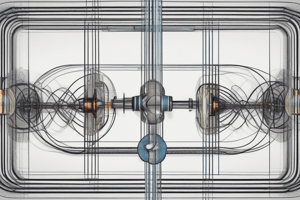Podcast
Questions and Answers
Which of the following is NOT a foundational concept in electrostatics?
Which of the following is NOT a foundational concept in electrostatics?
- Coulomb's law
- Electric potential
- Superposition of electric field
- Magnetic field (correct)
Coulomb's law describes the force between two charges. How does the force change if the distance between the charges is doubled?
Coulomb's law describes the force between two charges. How does the force change if the distance between the charges is doubled?
- The force is quartered. (correct)
- The force is halved.
- The force is doubled.
- The force is quadrupled.
What is the significance of the principle of superposition of electric fields?
What is the significance of the principle of superposition of electric fields?
- It simplifies the calculation of electric fields by allowing us to break down complex charge distributions into simpler parts. (correct)
- It describes the interaction of electric fields with magnetic fields.
- It allows us to calculate the electric field of a single charge.
- It explains why electric fields are always directed towards positive charges.
What is the origin of electric charge?
What is the origin of electric charge?
In which situations is the superposition of electric fields particularly useful?
In which situations is the superposition of electric fields particularly useful?
Flashcards
Origin of charge
Origin of charge
The fundamental source of electric charge in matter, often involving protons and electrons.
Coulomb's law
Coulomb's law
A formula that describes the force between two charged objects based on their charges and distance.
Electric field
Electric field
A region around a charged particle where other charged objects experience a force.
Superposition of electric field
Superposition of electric field
Signup and view all the flashcards
Electric field strength
Electric field strength
Signup and view all the flashcards
Study Notes
Electrostatics
- Charges exist in discrete amounts, a concept termed "quantized". Robert Millikan.
- Electric charge is conserved in isolated systems, but can be rearranged, distributed, or transferred.
- Charges come in two types: positive and negative. The fundamental unit of charge is the elementary charge (e) which is approximately -1.6 x 10-19 C or +1.6 x 10-19 C.
Contents
- Origin of electric charge
- Coulomb's Law
- Electric Field
- Superposition of Electric Fields
- Static charges
- Dynamic charges
Origin of Charge
- Charges occur only in discrete amounts.
- The electron charge is -1.6 x 10-19 C.
- The proton charge is +1.6 x 10-19 C.
- The total charge of a system is the sum of the charges.
- The total charge of an isolated system is conserved.
Coulomb's Law
- The electric field (E) due to a point charge (q) at a distance (r) from the charge is: E = k|q|/r2.
- Where "k" is Coulomb's constant = 9 x 109 Nm2/C2.
Electric Field
- The space around a charge in which electric effects appear is called the electric field.
Electric Field Lines
- Imaginary lines that flow in the space around the charge.
- Lines are tangent to the direction of the field at any point.
- The number of lines per unit area is proportional to the field strength.
- Field lines emanate from positive charges and terminate at negative charges.
- Lines are always perpendicular to the charge surface.
Superposition of Electric Fields
- The resultant electric field at a given point due to a number of charges is the vector sum of the electric fields of the individual charges at that point.
How to Determine Field Direction
- The sign of the charge affects the field direction. Positive charges have outward-pointing field lines, and negative charges have inward-pointing field lines.
Permittivity
- The ability of a medium to sustain electric field lines.
- Coulomb's constant depends on the medium.
- Permittivity of air (ε0) is 8.85 x 10-12 C2/Nm2.
- k =1/4πε0
Example Problems (General)
- The electric field at the center of a square.
- Finding the magnitude and direction of the electric field.
Example Problem 1
- Determine where the Electric field is zero in the electric field.
- Find the point along line where electric field is zero.
Example Problems (Specific)
- Provided diagrams of point charges and questions to determine the Electric Field.
Studying That Suits You
Use AI to generate personalized quizzes and flashcards to suit your learning preferences.




